I Don’t Care if I Ever Get Back: Bill Sisler in the Minor Leagues
This article was written by Will Christensen
This article was published in When Minor League Baseball Almost Went Bust: 1946-1963
 On May 9, 1950, Bill Sisler finally ended his baseball odyssey with a record that makes any other player look like a homebody.1 Sisler played for at least 44 different teams during his 23 active years in the minors between 1923 and 1950.2 Forty-four. It can’t be said with absolute certainty that it’s a record, but … it has to be.
On May 9, 1950, Bill Sisler finally ended his baseball odyssey with a record that makes any other player look like a homebody.1 Sisler played for at least 44 different teams during his 23 active years in the minors between 1923 and 1950.2 Forty-four. It can’t be said with absolute certainty that it’s a record, but … it has to be.
Further, Sisler signed contracts with eight other teams for which he didn’t play (two as a manager), and God only knows how many more teams gave him a tryout.3 Sisler played in 27 leagues4 (likely another record) as far north as Canada, as far south as Florida and as far west as Texas.5 He finished a season with a team only once—Syracuse in 1944—and played for the same team twice only once: Clarksburg in the Mid-Atlantic League in 1928 and in 1931—each stint totaling a single game.
Sisler was small (5-feet-6, 150 pounds) and didn’t throw hard, which certainly held him back to a degree. Although it’s unknown whether he used it his entire career, by 1943 at least, Sisler had developed a delivery that was described at various times as “tricky,”6 “confusing,”7 and “freakish.”8 The Syracuse Herald-Journal said he “swings his left hand around with the ball to his right hip before delivery.”9 Apparently, he did this repeatedly before making the pitch, to the point where opposing fans would call out “one, two, three …”10
More important, however, Sisler wasn’t much of a pitcher. Because he frequently pitched only a handful of games in most of his stops—12 of his stints consisted of just one game—his record is far from complete. What information we have tells the story, though.
Research has determined that, with a few stints missing from the record, Sisler went at least 47-72 during his career and had a 6.64 run average in 1,024 innings of work in which we can measure.
But where Sisler’s record really stands out is in the strikeout category. Sisler struck out 204 batters in 981% innings for which a record can be assembled, or a strikeout ratio of 1.87 per nine innings. It isn’t the lowest figure ever, but it probably is for someone whose career started after World War I.
In short, Sisler might have had difficulty throwing the ball through a plate-glass window. As a result, he was very easy to hit, allowing an average of 11.79 hits per nine innings for innings that we have a record for.
Every once in a while, it all worked. On May 11, 1944, Sisler pitched his only complete game on the Double-A level (then one step below the majors), lasting 10 innings and allowing only eight hits and two runs in a 3-2 victory over the Montreal Royals.11 It doesn’t appear that he ever threw a professional shutout. The best game found was a three-hitter with one run allowed in Sisler’s only victory for Drummondville in 1939.12
Obviously, Sisler won 47 actual professional games, so he had some ability, but really, how was he able to get so many chances to prove he didn’t really belong?
Several writers profiled Sisler over the years, although the definitive source is Ed Brooks, who was able to track down Sisler late in life and interview him about his singular career. Surprisingly, Sisler didn’t have much good to say, even that he wanted to “forget it.”13
Almost every profile portrays Sisler as … well, not heroic, but a player worthy of admiration, a model of perseverance. For example, Andrew Hendriks on the Canadian Baseball Network website wrote this about Sisler:
“A cynical man would call him a con artist. But to those passionate about the game, his story is one of tenacity, endurance and sheer dedication to a game in which he held so dear to his heart.”14
There’s no doubt Sisler loved baseball,15 but that’s beside the point. The truth is Sisler was a con artist, or at least a prevaricator, which might explain why he didn’t want to talk about his baseball career later in life. Because deceit was his modus operandi, on and off the mound, perhaps, later in life, it brought him some shame.
Clearly, Sisler was a master self-promoter and marketer, taking advantage of the difficulty and effort required at the time to check out stories. For example, for years it was reported, even as late as 1941, that Sisler played with the Cleveland Indians in 1932.16
Of course, he didn’t. In fact, no record exists that he even got a tryout with the team. In February 1932, The Sporting News ran an Indians spring-training roster that listed 16 pitchers.17 Sisler’s name wasn’t on it. By 1944, when Sisler pitched for Syracuse, which was a good-sized city with a decent following, no mention was made of his association with The Show.
Nor did it come up again when, late in his career, Sisler was hired to manage various teams and when managers, naturally, drew most of the ink in small towns. One would think fans in, say, Rehoboth Beach, Maryland, would want to know that their team’s skipper had a brush with the bigs, but nothing was written about it.
Maybe Sisler was invited to train in 1932 with the New Orleans Pelicans—where the Indians trained that year.18 Perhaps that later became conflated with “a trial with the Indians” by writers who wanted to puff up a new player’s credentials or by a certain left-handed pitcher. Who knows? You can draw your own conclusions.
All too frequently, the Sisler story played out the same: Sisler would arrive in town, typically a small town that had a losing team looking for anyone who might be able to pitch,19 on the recommendation of a scout or even, sometimes, a well-known major leaguer. (Rabbit Maranville, in St, Joseph, Michigan, was the most prominent name dropped.20) Then Sisler would take the mound, sometimes to initial success, more often to not, and soon after reality set in, would be sent on his way.
No one called him on it, until he got to Nyack, New York, in 1947. The local paper said this after Sisler’s release (after five games):
“Bill hooked on with the team through misrepresentation by calling the Rockies’ office and saying he was a Boston scout. According to a well-founded report, he then proceeded to sell the team on Sisler (himself) and also wrote a letter to the Nyack club. When Bill, old and way past 34 [he was 46] arrived in Nyack, the surprise on the part of the owners and manager of the team must have been great and probably would rival any comedy ever made.”21
Maybe, in fairness, all Sisler really was was the ultimate guy who could get the job, through manipulation and exaggeration if not outright untruths, but couldn’t do the job. (Today, through social media, Sisler probably would be a millionaire or in prison for fraud—or both.)
Heck, his name wasn’t even Sisler. It was Seeler.22 Adopting the surname of one of baseball’s biggest superstars at the time his career began in 1923—although familial ties weren’t always claimed—couldn’t have hurt the faux Sisler’s chances.23
Regardless, it still was a heck of a run.
WILL CHRISTENSEN is a former journalist, avid researcher, and certified minor-league baseball nut. He has been a member of SABR since 1986 and has been interested in minor-league baseball most of the time since then. His first game to watch was the Columbus Jets during the team’s final season in 1970.
Acknowledgments
This article was edited by Thomas Rathkamp and fact-checked by Tony Escobedo.
Notes
1 “Sisler Quits His Post as Team Pilot,” Syracuse Herald-Journal, May 11, 1950: 69. There’s no evidence Sisler played that year for Auburn in the Class-C Border League or the previous year when he managed in Rehoboth Beach in the Class-D Eastern Shore League, so his playing career seems to have ended in 1948.
2 Baseball-Reference.com lists Sisler playing for 41 teams, but playing records have been found for him in Ottumwa in 1925, Drummondville in 1939, and Granby in 1946. It’s possible more might be found.
3 Ed Brooks, “Bill Sisler: Career Minor Leaguer,” Baseball Research Journal 17 (1988): 10-12. The teams identified as having signed Sisler but for whom he seemingly didn’t play were Shamokin in 1927, Dayton in 1932, Muskegon in 1934, Terre Haute in 1935, Portsmouth (Virginia) in 1938, Fort Pierce in 1942, Rehoboth Beach in 1949, and Auburn in 1950. In the final two cases, he was signed as a player-manager. In addition, research found mentions of his getting a tryout or playing in Saginaw and Amarillo as well as with the House of David.
4 This counts the New-York Pennsylvania League, which took the Eastern League name in 1938, as the same league. Sisler had five stints in this league: 1923,1930,1933,1943, and 1945.
5 The corners based on his known playing record are Québec City; Daytona Beach, Florida; and Gainesville, Texas.
6 Howard Pierce, “Along the Sidelines,” Elmira (New York) Star-Gazette, July 28,1943:11.
7 “Sports from the Sidelines,” Nyack (New York) Journal News, July 29, 1947: 5.
8 Jack Durkin, “Down the Line,” Syracuse Herald-Journal, May 19, 1944: 31.
9 Durkin.
10 “Highlanders Win 10-1, 6-2; Lose, 5-2,” Peekskill (New York) Evening Star, July 28, 1947.
11 United Press, “Bill Sisler Hurls Chiefs to 3-2 Win,” Rochester Times-Union, May 12, 1943: 16.
12 “Local Nine Is Second in Provincial League,” Sherbrooke (Québec) Daily Record, May 22,1939:10.
13 Brooks, Baseball Research Journal: 17.
14 Andrew Hendriks, “William Sisler a Minor Leaguer Who Made 48 Different Stops,” Canadian Baseball Network, November 16, 2015, https://www.canadianbaseballnetwork.com/canadian-baseball-network-articles/2015/11/16/william-sisler-a-minor-leaguer-who-made-48-different-stops?format=amp. Note that the title is incorrect.
15 “Kiwanis Clinic Hopes to Move Outdoors,” Lockport (New York) Union Sun & Journal, May 17,1961:16. Several stories after his retirement from the pro game mention Sisler conducting baseball clinics and camps for area youth in upstate New York.
16 “Puerto Ricans Meet Trojans Tomorrow at 3,” Berkshire Evening Eagle (Pittsfield, Massachusetts), June 14, 1941: 16.
17 “Roster of the Cleveland Indians,” The Sporting News, February 4,1932: 6.
18 “Players on 14 Major League Teams Swinging Into Hard Work at Camps,” The Sporting News, February 25, 1932: 6.
19 Eleven of the 44 teams Sisler seemed to have played for finished with a winning record, including two who were right at .500. Conversely, 12 of the teams finished last in their league.
20 “Vet Southpaw Hurler Joins Autos Lineup,” Benton Harbor (Michigan) News-Palladium, August 2, 1940: 9. Other prominent names mentioned over the years included major leaguers Fred Merkle, George Selkirk, and Ripper Collins, an impressive network for a player who only made it to Double-A ball during World War II.
21 “Sports from the Sidelines,” Nyack Journal News, August 11, 1947: 5.
22 Brooks, Baseball Research Journal: 17.
23 “Jimmy Shelton Named Pilot of South Boston Ball Team,” Danville (Virginia) Bee, March 12, 1937: B7. In this story, which named Selkirk as the link to the job, Sisler was called “a cousin of the famous George.”

